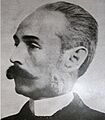G. Dem. Teodorescu facts for kids
Gheorghe Dem Teodorescu (born August 25, 1849 – died August 20, 1900) was a famous Romanian expert in folklore, a historian of literature, and a journalist. He spent his life studying and collecting old Romanian stories, songs, and traditions.
Contents
Early Life and Education
Gheorghe Dem Teodorescu was born in Bucharest, the capital of Romania, in 1849. He was the only child in his family. From a young age, he loved listening to and collecting traditional stories and songs, even from his own parents.
He went to school in Bucharest, attending Gheorghe Lazăr Gymnasium and Matei Basarab High School. While still a teenager, he started working at the Ministry of Education. He also began writing for the newspaper Românul, where he published articles about folklore and literature. His first articles about folklore explored how Christmas traditions might be linked to ancient festivals.
In 1870, he started writing for another newspaper called Ghimpele. He used the pen name Ghedem and became known for his funny, satirical poems. He also traveled as a correspondent for Românul to Putna Monastery to report on a special anniversary.
Teodorescu also studied at the University of Bucharest, focusing on literature and philosophy. He was very interested in ancient Greek and Latin studies. He learned a lot from his professors, who inspired his later work on folklore. In 1875, he received a scholarship to study in Paris, France, at the University of Paris. There, he learned about Western folklore studies and how important it was to collect texts carefully. He also understood how Romanian folklore connected to other cultures' traditions.
Teaching and Research
When Teodorescu returned from France, he became a teacher at Saint Sava High School in Bucharest, teaching Romanian and Latin. In 1877, he published an important book called Cercetări asupra proverbelor române (Studies on Romanian Proverbs). This book showed how to collect and study Romanian proverbs, making him one of the first Romanian scholars to see the strong connection between language study (philology) and folklore. He used what he learned in Paris to compare Romanian proverbs with those from other countries.
In 1878, he became a full-time teacher at Saint Sava and later taught Romanian language and literature at Matei Basarab High School, where he eventually became the director in 1885.
In 1879, he published another significant work, Literatura poporană. Noțiuni despre colindele române (Folk Literature. Notes on Romanian Carols). In this book, he explored Romanian Christmas carols, showing their ancient roots and how they reflected old customs and even historical events. He also wrote the first Romanian book on Latin poetry rules, called Tratat de versificare latină.
Collecting Folk Poetry
One of Teodorescu's most important achievements was his work on Poezii populare române (Romanian Folk Poems). In 1883, he met a talented traditional musician and storyteller named Petrea Crețu Șolcan from Brăila. Șolcan became a key source for Teodorescu's collection, sharing many ballads and folk songs.
In 1884, Teodorescu introduced Șolcan to the public at the Romanian Athenaeum, showing how important it was to recognize the people who kept these traditions alive. He also pointed out that earlier collectors, like Vasile Alecsandri, sometimes changed the original folk poems to make them sound more "polished." Teodorescu believed in keeping the texts exactly as he heard them. Șolcan provided him with 137 pieces, totaling over 15,000 verses, which was a huge part of Teodorescu's collection.
Poezii populare române was published in 1885. It was a massive collection and the result of twenty years of gathering folklore. Teodorescu made sure to include notes about where and when he collected each piece, and who told him the story or song. This scientific approach was praised by other scholars.
Public Life and Later Works
Teodorescu was also involved in politics. He was elected to the Romanian Parliament in 1888. In 1891, he briefly served as the Minister of Education. During this time, he helped establish the Carol I Academic Foundation, which was an important institution for education and culture.
He continued his research and writing. In 1891, he published a study on the works of Anton Pann, another important folklorist from the 19th century. In 1893, he published Istoria filosofiei antice (History of Ancient Philosophy), which covered philosophy from ancient times to 750 AD. This book won an award from the Romanian Academy. He also wrote the first biography of Anton Pann in 1893.
In 1895, Teodorescu became the first director of the Carol I Academic Foundation. He worked to build up its library and activities. In 1898, he published a study called Miturile lunare. Vârcolacii (Lunar Myths. Werewolves), where he explored the history of werewolf myths across different cultures, from ancient times to the Balkan peoples and Romanians. He showed how superstitions evolved into myths and customs.
Death and Lasting Impact
Gheorghe Dem Teodorescu passed away in August 1900, just before his 51st birthday, due to an infection. He left behind his wife and two young children. He was buried in Bellu cemetery in Bucharest.
Even after his death, his work continued to be important. In 1902, a bronze statue of him was created and placed in the Athenaeum garden. Many of his unpublished writings were later released.
His most famous work, Poezii populare române, was republished many times, including a complete edition in 1982. This edition included detailed notes and explanations of his research methods. In 1968, twelve folk tales he had collected but remained unpublished were finally released as Basme române (Romanian Fairy Tales).
Gheorghe Dem Teodorescu is remembered as a pioneering folklorist who collected and preserved a vast amount of Romanian traditional culture. His careful and scientific approach to studying folklore helped future generations understand the richness of Romania's heritage.
Images for kids


